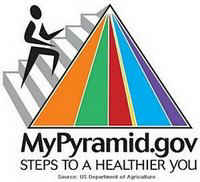The vegetarian nutrition food pyramid gives the main food groups of a healthy balanced vegetarian diet. What food groups you should eat to keep yourself healthy if you are vegetarian? According to official US dietary guidelines, each of these groups provides some, but not all of the nutrients you need.
Foods in one group cannot replace those in another. All the groups in the vegetarian food pyramid are equally important. For good health, you need them all. Most of the calories you consume, should come from foods from three lower section of this pyramid.
Using the Food Guide Pyramid you can choose a healthy diet that is right for you.
Vegetarian Health Benefits | Vegetarian Nutrition | Vegetarian Types | Food Serving Size | Food Substitute | Non-vegetarian foods in Vegetarian Meals | Non-vegetarian foods in Vegetarian Meals | Vegetarian Diet
Whole Grains: 6 - 11or more servings a day
This group includes bread, rice, pasta, cereal. corn, millet, barley, buglar, buckwheat groats, and tortillas.
Vegetables: 3 - 5 or more servings a day
Include generous portions of a variety of dark green vegetables such as broccoli, collards, kale, mustard and turnip greens, etc; and yellow vegetables such as carrots, winter squash, sweet potatoes, and pumpkin in your diet. These are packed with nutrients such as they provide vitamin C, beta-carotene, riboflavin, calcium, iron, fiber, and other nutrients.
Fruits: 2 - 4 or more servings a day
Include a variety of fruits in your diet. These are packed with fiber, vitamin C, and betacarotene. Whole fruits are better than fruit juice as fruit juices do not contain fiber.
Legumes: 2 - 3 or more servings a day
Legumes such as beans, lentils, chickpeas, soy milk, tempeh, and texturized vegetable protein are packed with fiber, protein, iron, calcium, zinc, and B vitamins.
Blank Food Pyramid
Teach your kids about nutrition at an early age. The following blank printable food pyramid chart or diagram can be a fun for kids to learn about good health and food.
Blank food pyramid
The vegetarian food pyramid gives the main food groups of a healthy balanced vegetarian diet. According to official US dietary guidelines, each of these groups provides some, but not all of the nutrients you need. Foods in one group can not replace those in another. All the groups in the vegetarian food pyramid are equally important. For good health, you need them all. Most of she calories you consume, should come from foods from three lower section of this pyramid.

USDA has released it's interactive dietary guidleines, Mypyramid (www.mypyramid.gov) considering US federal new food guide pyramid in April 2005. The old food pyramid recommended one food size for all without emphasizing on exercise, so many people today are faced with weight problems.
Compare the old and new pyramids. The new pyramid consists of 6 colored bands and one stair case. The 6 colored bands represent the 5 food groups plus oils.

- Orange band for grains, mostly whole grains. Whole grain foods include oatmeal, whole wheat flour, whole cornmeal and rice.
- Green band for vegetables: Choose a variety of colorful vegetables.
- Red band for fruits: Any fruit or 100 percent fruit juice.
- Yellow band for fats (oils) sugars,and salt (sodium): This is the narrowest band, means eat these minimum. Select good fats from fish, nuts and vegetable oils. Limit solid fats like butter, stick margarine, shortening and lard.
- Blue for milk: Eat calcium rich foods for your bones.
- Purple band for meat and beans: Vary your protein, choose from fish, nuts, seeds, peas and beans.
- Steps and the person climbing them represent physical activity.
Because Vegetarians do no eat meat, fish, poultry or dairy foods so it is generally said that they are at the risk of nutritional deficiency. This is not the case. Vegetarins get major nutrients for the following foods:
- Calcium: tofu, broccoli, seeds, nuts, kale, bok choy, legumes, greens and iron-fortified cereals and breads, foods high in calcium
- Iron: legumes, tofu, green leafy vegetables, dry fruit, whole grains, and iron-fortified cereals and breads. The absorption of iron is improved by vitamin C
- Protein: legumes and lentils such as black-eyed peas, chickpeas, kidneybeans, mung dal, rice, whole-wheat, bulgur, oats, millet, barley, buckwheat, peas, peanuts, sprouts, etc.
- Vitamin C: citrus fruits and juices, tomatoes, strawberries, broccoli, peppers, dark-green leafy vegetables, potatoes
- Vitamin D: sun rays and fortified foods
- Vitamin B12: Vegetarians can get vitamin B12 from cereals, cheese and fortified soy milk or fortified milk, dairy products, soyabean, legumes, cottage cheese, etc.
- Zinc: whole grains, wheat germs, breads, legumes, nuts, and tofu.

